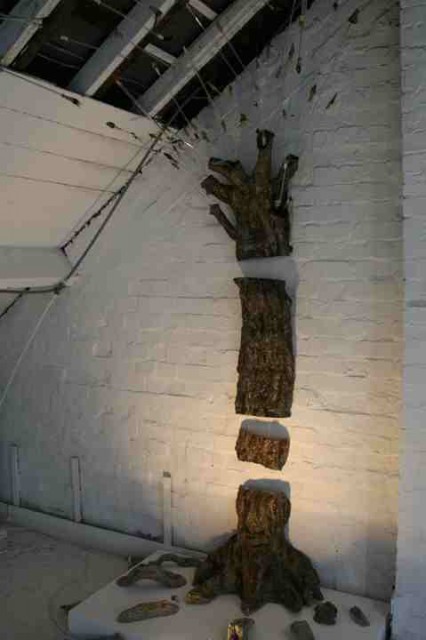Joao Morais takes time out to relish the latest exhibition of sculpture, performance, photography and drawing in his review of Wunderland II.
Following on from last year’s Wunderland group show, tactileBOSCH once again hosts another show in celebration of International Women’s Day. Wunderland II, initiated by the Women’s Art Association, is an eclectic collection of sculpture, installation, video, performance, photography and drawing. Memory and the private lives of women are explored in all forms, and run concurrently throughout most of the works.
The gallery is on the first floor of an old Victorian laundry house in Llandaff North. Sarah Dunstan’s ‘Wedding Dress’ is a welcoming choice at the top of the staircase. The piece consists of five photographs containing the same model, wearing a different wedding dress in each scene, and posing on a different bed. She never meets the viewer’s gaze, preferring to look away instead. The viewer arrives at the pentaptych with certain locational and sartorial presumptions, which they are forced to reconsider having had the intimacy luxated from them.
Upon turning around, towards the middle of the gallery space, is Eleanor Francis’s ‘Untitled (my breath)’ which also questions the intimacy of the private space. This installation consists of 288 condoms, each inflated and then inserted between the coils of a stripped, rusting spring mattress. The occasional condom is deflated. Using both inflated and deflated condoms gives the viewer a strong visual metaphor on the nature of human relationships. At once unsettling and humorous, the gallery’s curator, Kim Fielding, intends to ask Francis to consider turning this into a performance piece for a future show.In much the same way, Ruth Wallace highlights the role of women in her charcoal drawings on the gallery’s far wall, particularly in ‘Trace IX’. In a darkened room, a long-

Another theme explored is how memory relates to belonging. Susan Zepellini’s ‘Up-
This piece in particular demonstrates the limitations of using an old building. As the piece was next to the roof, the tiles distracted somewhat from the overall atmosphere; I can’t help but feel that it would have had a bigger impact on the viewer had it been hung in the opposite corner, where the roof is covered in white rafters. However, as this piece relies on a powerful light to illuminate the beautiful and earthy browns and greens of the ceramics, the only available socket in a building that was undoubtedly wired a long time ago was in the nearside corner, making this impossible. Nevertheless, it was indeed one of the standout pieces of this show. Underneath this opposite wall is Sarah Ellis’s installation, ‘Nature of the Finds’. Everyday objects, such as a cooking pot and a grille, are clad in earth and leaves, giving off the sense of a memory, and is indeed worth viewing in conjunction with Zeppellini’s work.
The opening of LP Hartley’s classic novel, The Go-
Memory is also an important theme to Fern Bowen in her installation, ‘Untitled’. On the gallery wall is a large text, situated behind a bedded sheep-
There is much to recommend in this show, such is its eclectic nature. In a world where International Women’s Day is still needed to highlight the need for equal human rights, I can only hope that the Wunderland series returns next year.
Wunderland II Photographs by Jess Matthews











